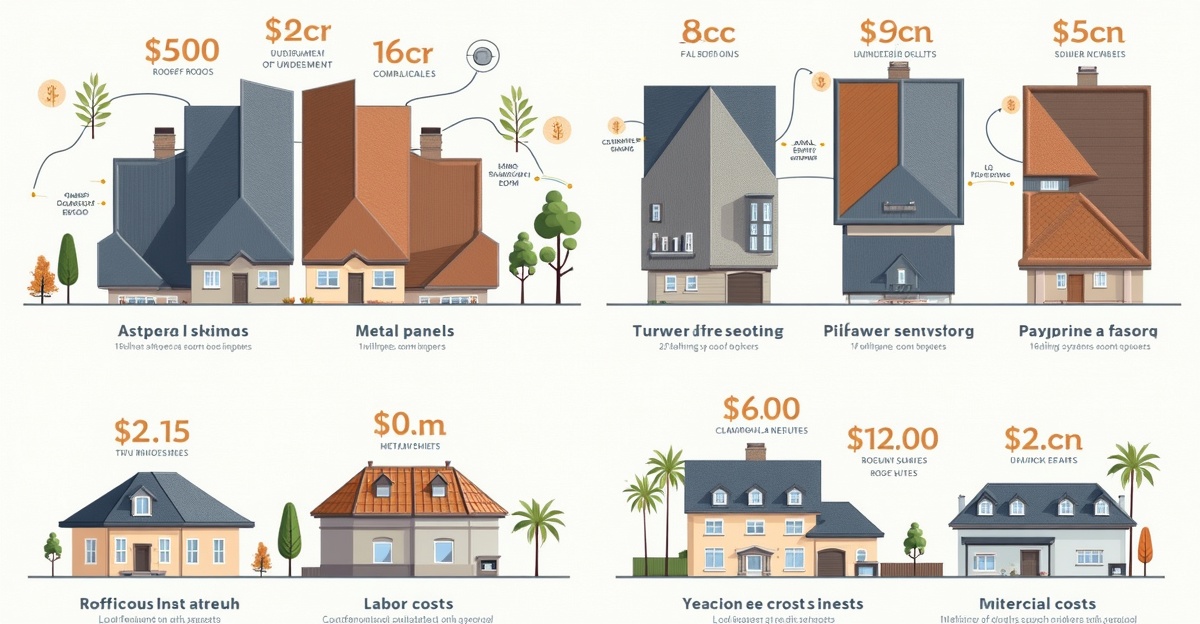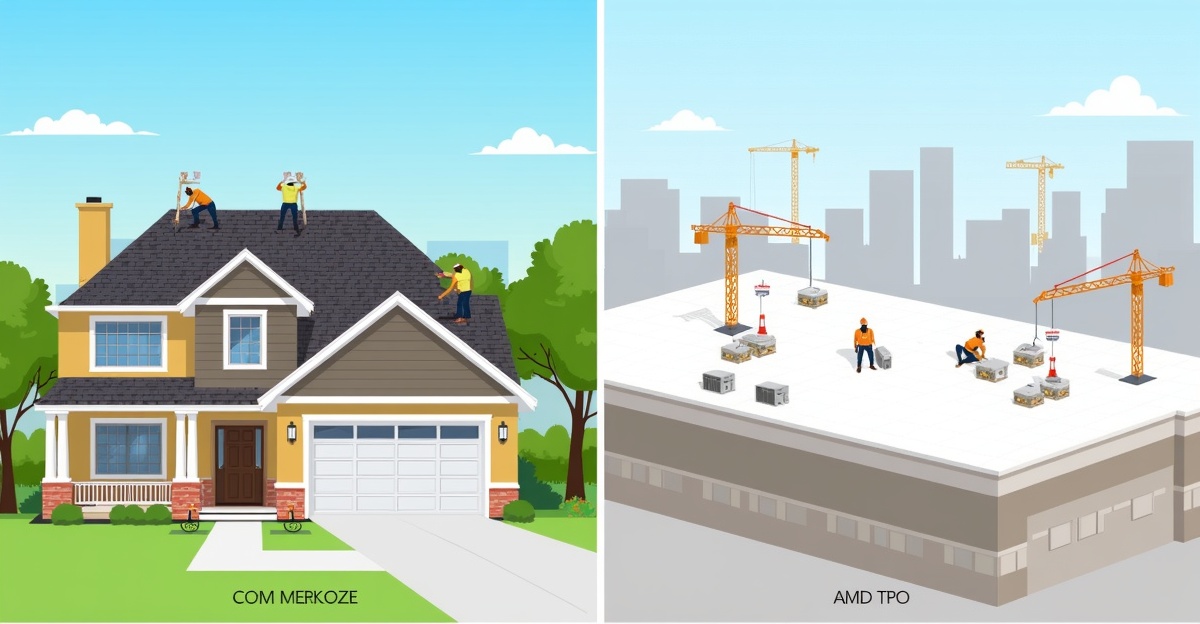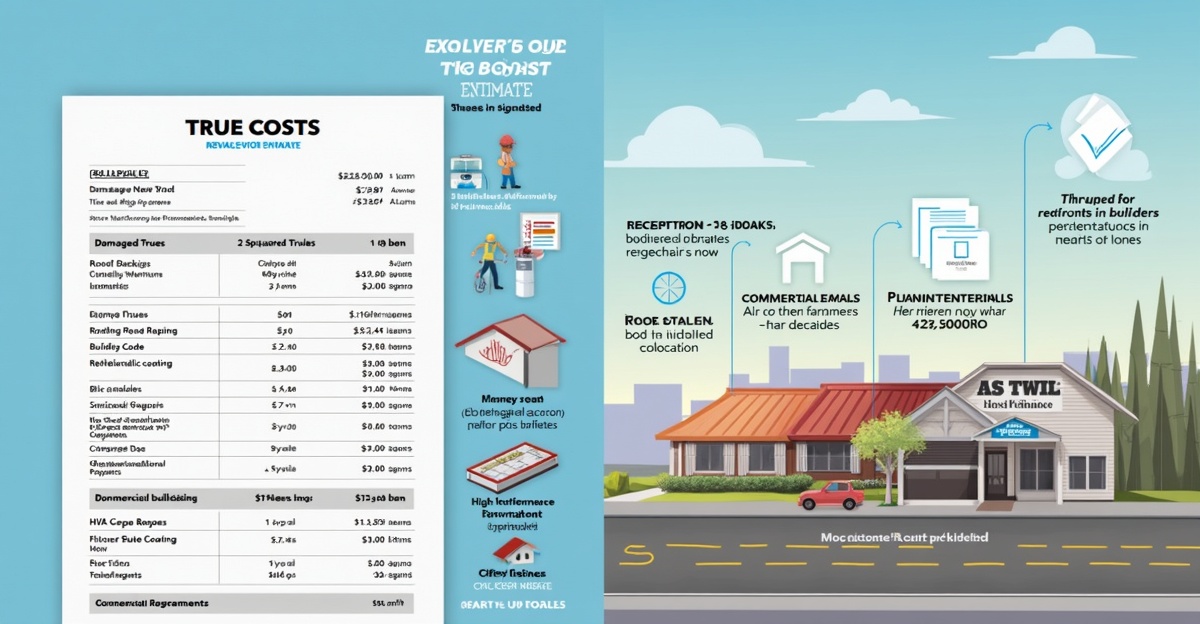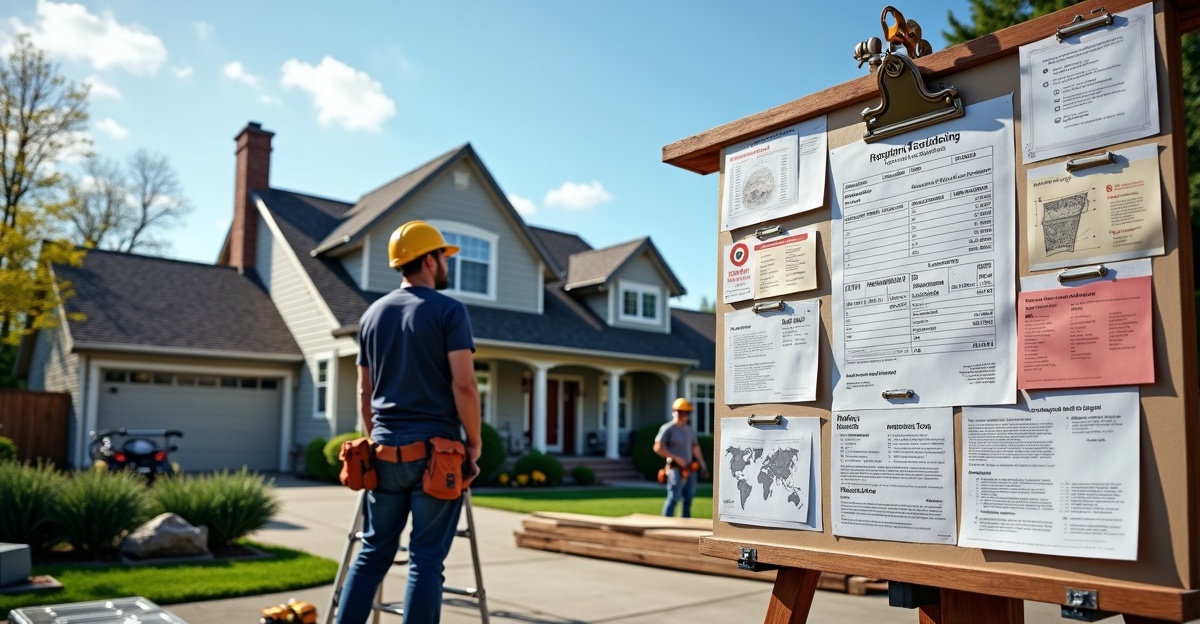The Cost Breakdown of Roof Replacement

Understanding what affects roof replacement costs allows us to plan ahead and avoid unexpected charges. This 2024 roof replacement pricing guide breaks down the expenses based on property type, material choice, labor, and additional factors so we can build a reliable budget.
Key Takeaways
- Replacing a residential roof usually costs between $7,000 and $15,000 for a 2,000 sq. ft. home using asphalt shingles. Regional pricing and material selection can raise or lower that range.
- Commercial roofing averages $3.50 to $10.00 per square foot. Extra charges often apply due to site access, building codes, and the scale of commercial projects.
- Labor accounts for 40% to 60% of the total price. Removing the old roof, obtaining permits, and hauling away waste can add $2,000 to $5,000, depending on the roof’s shape and age.
- Additional improvements like updated ventilation, repair of underlying structures, or adjusting to meet code are common and come with higher costs. These often don’t appear in the first quote.
- Lower upfront estimates might skip important parts of the work. Every proposal should clearly list materials used, job duration, warranty details, and cleanup after the install. Always compare details, not just bottom lines.

What You Can Expect to Pay: Average Roof Replacement Costs by Property Type
Replacing a roof is one of the biggest investments a property owner can make. Whether it’s your family home or a commercial building, costs vary based on size, material, and installation requirements. We’ve laid out current 2024 rates so you can make a clear decision with real expectations.
Residential Roof Replacement Costs
For homeowners, a new roof typically ranges between $4.50 and $12.00 per square foot. That includes tear-off, materials, and installation. On average, you’re looking at $7,000 to $15,000 for a 2,000 sq. ft. home using asphalt shingles—the most used residential option in the U.S.
Here’s how the costs play out per material:
- Asphalt Shingles: Most common, reliable, and cost-efficient. Falls between $3.50–$5.50 per square foot installed.
- Metal Roofing: Known for durability. You’ll pay $7.00–$12.00 per square foot, depending on style and type of metal.
- Tile Roofing: Durable but heavier and pricey. Ranges from $10.00–$18.00 per square foot. More popular in hot, dry regions like the Southwest due to heat resistance.
- Wood Shakes: Offer a distinct look at around $6.00–$9.00 per square foot, though they require more maintenance.
- Slate and Premium Materials: Can push costs up to $20.00+ per square foot.
If you’re comparing price points, our full roofing material pricing comparison breaks down each material’s average cost and performance.
Installation costs change by location too. Roofs in coastal or storm-prone areas require specialized underlayments and fastening systems, which can raise the final bill. Warmer climates often use tile or metal, while asphalt remains dominant in the Midwest and Northeast due to affordability and insulation value.
If you’re weighing options, our roof replacement cost guide lays out everything you need—from material trends to planning tips. You can also explore our full range of residential roofing services for more info.
Commercial Roof Replacement Costs
Commercial roof replacement runs on a larger scale—both in square footage and design complexity. In general, you’ll see pricing from $3.50 up to $10.00 per square foot depending on the material and system.
For flat and low-slope commercial roofs, the most common systems include:
- TPO (Thermoplastic Polyolefin): Energy efficient and widely used. Costs between $4.00–$7.00 per square foot.
- EPDM (Ethylene Propylene Diene Monomer): Durable rubber membrane. Pricing is around $3.50–$6.50 per square foot installed.
- Modified Bitumen: Reliable in varied climates. Costs between $4.00–$7.50 per square foot. For a deeper dive, check out our modified bitumen roofing cost guide.
- Built-Up Roofing (BUR): Often layered with tar and gravel. Tends to hit $5.00–$9.00 per square foot installed.
For complex or high-square-foot commercial projects—with multiple penetrations, special drainage, or structural issues—costs can reach or exceed $100,000 easily. If you’re in planning mode, our commercial roof replacement cost guide explains what drives up labor and material numbers on those big builds.
Interested in options for a flat commercial property? Our flat roofing services detail what’s available and why one system might work better than another based on building layout and climate.
Material Comparison: Cost Per Square Foot
Here’s a quick look at common roofing materials and what you can expect to pay installed in 2024:
| Roofing Material | Avg. Cost per Sq. Ft. (Installed) |
|---|---|
| Asphalt Shingles | $3.50 – $5.50 |
| Metal Roofing | $7.00 – $12.00 |
| Tile Roofing | $10.00 – $18.00 |
| Wood Shakes/Shingles | $6.00 – $9.00 |
| Slate/Premium Stone | $15.00 – $25.00 |
| TPO (Commercial) | $4.00 – $7.00 |
| EPDM (Commercial) | $3.50 – $6.50 |
| Modified Bitumen | $4.00 – $7.50 |
For a breakdown on how material choice affects the total bill, this deep dive into roof cost per square foot unpacks the numbers in more detail.
No matter the type of roof, proper install matters just as much as the material. You can check out our roof replacement services to see how we handle everything from inspection to final cleanup. Getting that investment right prevents costly issues down the line.
We bring the same honest, experienced approach to both homes and commercial properties. Our goal is to give you clarity, not confusion—because you shouldn’t have to guess how much a new roof costs.

What Goes into That Number: Full Cost Breakdown Component by Component
Every roof replacement estimate is built from the ground up—literally. Understanding the parts of the quote can help cut surprises and give us better control of the budget. Here’s how that total cost takes shape.
Major Cost Components
We break total roof replacement costs into smaller buckets. Each plays a part in your overall price:
- Materials: Your choice here affects everything else. Asphalt shingles are the most affordable and still get the job done. But tile or metal roofs—like standing seam panels—cost more upfront. You’re paying for durability and aesthetics. Take a look at our roofing material cost guide to compare options.
- Labor: Expect labor to make up 40% to 60% of the total cost. It depends on how complex the job is—steeper slopes, multi-level homes, or multiple penetrations (vents, skylights) all mean more crew hours.
- Tear-off of Old Roofing: Stripping off the current roof runs about $1 to $5 per square foot. More layers cost more to remove. If there’s more than one layer or you’ve got heavy material like tile, demo gets pricier. This is a key piece of the roof replacement cost breakdown.
- Underlayment, Decking, and Ventilation Repairs: These are the behind-the-scenes essentials. If the plywood decking is damaged—or the attic isn’t venting right—we need to fix it. Typically, this can add $1,000 to $3,000. But these fixes extend your new roof’s life and keep things code-compliant.
- Permits and Inspections: Most cities require permits for roof replacement. Fees start around $150, but can top $1,000 in stricter areas. Cost depends on location, roof type, and property type. Check with your town or let us handle the permits for you. We always include fees in roofing contractor estimates so there are no hidden charges.
- Disposal and Cleanup: Once the job wraps, cleanup begins. Dumpster rentals and landfill fees usually add $300 to $1,000. We make sure your yard looks like we were never there—minus the fresh roof.
What These Terms Really Mean
Not everyone works in roofing, and we respect that. Here’s how we define some of the more technical terms:
- Underlayment: A water-resistant barrier installed under your shingles. It’s a second layer of protection against leaks.
- Decking: The wooden boards that make up the surface of your roof. Think of it as the foundation the rest of the roof sits on.
- Ventilation: How air flows in and out of your attic. Good ventilation helps prevent mold, rot, and higher energy bills.
Each of these matters. That’s why we never skip steps or cut corners. If you’re comparing estimates, check what’s really included. Some contractors skip tear-off, permit handling, or ventilation upgrades—stuff you’ll end up paying for later.
You can also dive deeper into the numbers with our full guide to residential roof replacement cost. Or if you’re thinking metal, get a full breakdown using our metal roof cost guide.

What Property Type Means for Pricing: Residential vs. Commercial Considerations
Residential Priorities and Price Drivers
Residential roof replacement focuses on protecting a family’s home—so priorities are different from commercial jobs. Pricing is influenced by aesthetics, budget, and turnaround time. Speed matters, especially if the home is occupied during the work. And since personal budgets often shape decisions, homeowners tend to balance cost with safety and curb appeal.
Key factors that drive residential roof installation pricing include:
- Simpler roof designs with slopes and valleys that add labor time
- Choice of material—shingles remain popular due to cost and look
- Smaller surface area but more detail work around features like chimneys and dormers
- Strong emphasis on keeping the family and interior safe during the work
- Insurance may help with costs, especially around storm damage
We usually recommend standard shingles or metal for homes. You can see a quick breakdown in our guide on residential roof replacement cost.
Commercial Considerations and Larger Influences
Commercial jobs demand more planning, logistics, and compliance—but they also carry bigger long-term ROI. These buildings often need flat or low-slope systems built for performance, not looks. Commercial roof replacement cost isn’t just based on square footage. It’s shaped by structural demands, energy efficiency goals, local codes, and how much the work disrupts operations.
Here’s a quick look at how commercial jobs differ:
- Code compliance and inspections from local authorities
- Roof access coordination (especially on high-rise or multi-tenant structures)
- Warranty requirements that may extend 20+ years
- Energy performance standards (cool roofs, solar compatibility)
- Insurance requirements and liability planning
- Occupant coordination—some projects mean off-hours or phased work
- Material choice includes TPO, EPDM, or torch-down—more on that in our modified bitumen cost guide
These projects often stretch over multiple sites or large square footage, which affects both manpower and material logistics. You’re also talking multi-million-dollar properties with higher risk if things go wrong. Our commercial roofing service team builds cost estimates that cover both upfront pricing and long-term value—because downtime and leaks cost more than materials.
For a broader look at both property types, check out our breakdown by roof cost per square foot.
Whether you’re overseeing a retail portfolio or fixing a house roof after a storm, the right plan begins with clear pricing and expectations. We help you compare material options, timelines, and risk factors on every job.

The Hidden and Long-Term Costs You Can’t Afford to Ignore
What Doesn’t Show Up in the Initial Estimate
Roofing contractor estimates often focus on square footage and material choices—but leave out critical cost drivers that come back to bite you later. Here are some hidden roofing costs that don’t always make it on paper:
- Code Upgrades: Local building codes may have changed since the roof was last installed. If your current system doesn’t meet today’s standards, you’ll need upgrades to pass inspection. That’s not optional—it’s required, and it adds up fast.
- Structural Repairs: Once we strip off the old roofing, we sometimes find rotten decking, truss damage, or sagging areas. It’s impossible to estimate structural repair costs accurately until the old system is removed, but you should always budget a margin for this.
- Energy Efficiency Upgrades: Reflective coatings, added insulation, or cool roofing materials cost more up front but can significantly cut down utility bills over time. For flat or low-slope buildings especially, investing in something like a white modifier or added R-value can reduce heat absorption and pay off faster than expected.
- Maintenance Needs: Some materials demand more care. For example, modified bitumen and built-up roofs on commercial buildings perform well, but they need regular inspections. We break this down more in our full guide to modified bitumen roofing costs.
- Downtime for Commercial Sites: Replacing a commercial roof slows everything down. Whether it’s lost rental income because tenants can’t access a unit or operational delays due to partial shutdowns—these soft costs hurt. If your contractor’s not familiar with phased planning and after-hours installation, you’ll likely absorb some loss there.
The Real Value of Smart Upgrades and Warranties
Upfront cost doesn’t always tell the full story. Sometimes paying more means saving thousands in the future.
Think about these long-term payoffs:
- High-Quality Warranties: A solid manufacturer warranty paired with a contractor workmanship guarantee gives you more protection down the line. If something fails—whether it’s a leak from improper flashing or material separation—you’re covered. Always ask what voids the warranty, who registers it, and how long coverage lasts.
- System Upgrades That Pay Off: Integrated systems matter. Upgrading underlayment, using better ventilation, and sealing joints with high-performance products increases your roof’s efficiency and lifespan. You spend a little more now but reduce risk of premature failure or costly internal damage later.
- Material Choices: A great example is metal roofing. It can cost more at install, but it lasts much longer and reflects more heat. Review the details in our full metal roof cost guide to see how the numbers play out over time.
We always recommend thinking beyond install price when reviewing a new roof estimate. It’s better to identify long-term value than chase low bids that fail six years in.
Smart Questions to Catch the Costs Others Miss
You don’t need to know everything about roofing—we’re the ones that handle that. But there are smart ways to spot gaps in roofing contractor estimates. Ask questions that reveal full ownership costs:
- Does your quote include code-required upgrades?
- How do you handle decking replacements if needed?
- What’s included in your warranty, and how do we register it?
- Are there savings with alternate material types or coatings?
- How long will installation take, and what access will we lose during that time?
- Do you offer plans to maintain the roof after install?
- Are there recommended upgrades that add years to the system?
If you’re dealing with residential roofing, these details affect your comfort, curb appeal, and long-term safety. If it’s commercial, missed costs impact NOI, tenant retention, and operating budgets. In both cases, cutting corners never pays off.
You can learn more about full replacement pricing with our deeper breakdown of residential roof replacement costs and total cost of roof replacement for all property types.
When you’re ready for transparency and zero surprises, talk to us. We handle full roof replacements with planning that covers the knowns—and the unknowns.

How to Read a Roofing Estimate (and Spot Red Flags)
We’ve seen a lot of roofing contractor estimates in our time—some good, many not so good. If you’re looking at a new roof estimate, clarity is key. You need to know exactly what you’re paying for and what’s being promised. The cheapest quote isn’t always the best deal, especially if it skimps on essentials or skips over compliance.
What to Look for in a Roofing Estimate
A quality estimate should break things down clearly so there’s no confusion later. Here’s what we always include—and what you should expect to see:
- Labor and materials costs: These should be detailed separately. A flat total with no breakdown is a red flag.
- Tear-off and disposal: If the old roof needs removal, this should be included. Some quotes hide it or charge extra later.
- Underlayment and flashing: Critical for moisture control—if they’re missing from the estimate, that’s an issue.
- Ventilation work: Proper airflow extends the life of your roof. It should be addressed openly.
- Permits and inspections: If a permit is needed, your contractor should handle it. If it’s missing from the quote, ask why.
- Warranty terms: Look for details on manufacturer and workmanship guarantees.
- Timeline and cleanup: A good estimate outlines how long it’ll take and how the job site will be left.
If you notice line items missing or described vaguely—like “roof install package” without specifics—you’re being set up for surprise charges or corner-cutting.
We don’t play guessing games. Our estimates show you exactly what you’re getting, from shingles to flashing. Everything’s laid out in plain language. You’ll never be hit with mystery fees halfway through the job. That’s how we’ve earned trust across every project, from storm repairs to full roof replacement.
We’ve also built educational tools along the way. If you’re comparing costs, our breakdown of the residential roof replacement cost explains what drives prices up or down. Curious about square footage pricing or material types? Start with the guide on roof cost per square foot to build a realistic budget.
Not every contractor operates with transparency. We’ve seen estimates that skip permits, gloss over warranty terms, or “assume” homeowner cleanup. Those missing line items could cost you thousands later or leave you dealing with code violations. Always ask: is this number the full project or just a piece?
If you’re ready to move forward with a roofing partner who respects your budget and your time, check out our full roof replacement service. We bring clear pricing, dependable work, and none of the runaround.

Getting the Best Value with RayPro
We’ve replaced thousands of roofs across homes and businesses, and every project has the same goal: deliver lasting protection without wasting a dollar. That’s why we don’t just quote—you get a detailed plan that shows where every bit of your investment goes. Our roof replacement cost guide doesn’t hide fees or sneak in surprises. We spell out labor, materials, permits, and everything in between, so you know exactly what you’re paying for.
Our crews show up with respect and purpose. On residential jobs, we make sure your home life stays as peaceful as possible. Clean workspaces, friendly crews, and no high-pressure tactics—just honest roofing done right. You’ll always know who’s on your roof and what’s coming next. We walk you through your options, and we never push upgrades you don’t need.
For commercial projects, we understand the stakes are higher. Code compliance isn’t optional—it’s essential. So is working around business hours when needed. Our team plans ahead to limit disruptions, keep teams safe, and stay on schedule. We factor build type, safety needs, ongoing operations, and long-term efficiency into every estimate.
Why RayPro Delivers Better Long-Term Value
Here’s what sets us apart from the average roofing contractor:
- Transparent estimates with itemized labor, materials, and disposal costs
- Knowledge of local and updated building codes for both homes and businesses
- On-site evaluations that consider structure, ventilation, and energy use
- Material options presented with real durability and maintenance data, not just price tags
- Warranties matched to roofing systems, not vague blanket promises
- Projects managed start to finish by professionals—not subcontract crews
Whether you’re comparing roofing material pricing or want to understand differences in performance, we give straight answers you can use. Some choices may cost more up front, but they save you time, repairs, and hassle later.
To see how systems and pricing stack up, you can dig deeper into our resources—like this breakdown of roof replacement costs or our detailed cost per square foot guide.
Ready to talk specifics? Our team’s here to walk your property, go over your goals, and give you a quote that reflects your roof—not someone else’s template. Whether you’re a homeowner or a facility manager, we make the numbers work for your space, needs, and timeline.
Get started by visiting our page on roof replacement services or contacting us directly for a no-obligation estimate. Our advice is free, our pricing is fair, and our work will pay off for years.
